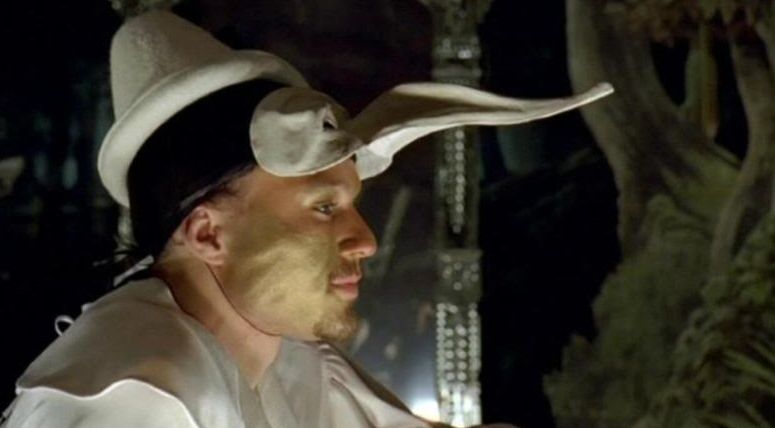The Furniture: The Chicanery and Posterity of 'The Imaginarium of Doctor Parnassus'
 Monday, January 22, 2018 at 2:50PM
Monday, January 22, 2018 at 2:50PM "The Furniture," by Daniel Walber, is our weekly series on Production Design. You can click on the images to see them in magnified detail.

The Imaginarium of Doctor Parnassus will always be known, perhaps primarily, as the movie interrupted by the tragic and sudden death of Heath Ledger (10 years ago today). This part of its reputation precedes it, particularly given its relatively muted critical reception. The story of its making, and the enlisting of Johnny Depp, Jude Law and Colin Farrell to fill the void, is essential to its reputation. It’s become a marker in time, an unplanned moment in the history of celebrity culture.
It is also, interestingly, a fairly specific moment in the development of visual effects. It lost the Best Production Design Oscar to Avatar, after all. These films stand for two dramatically different ways of using design and CGI to create cinematic worlds, even if they are both fantasies on the surface. And, perhaps, The Imaginarium of Doctor Parnassus comes out ahead...

The difference is one of philosophy. Avatar takes its immersiveness extremely seriously. Its images are meant to feel real, even if they depict a fictional planet. Part of this has to do with the use of 3D, hailed as the beginning of a new age. Like the advent of color, evangelists insisted, this would bring the cinema closer to the richness of reality.
The Imaginarium of Doctor Parnassus, meanwhile, is quite clear about its own fakery. The work of production designer Anastasia Masaro, set decorator Caroline Smith and the team of four credited art directors (including Terry Gilliam himself) is playful and self-aware. The traveling theater of Doctor Parnassus (Christopher Plummer) is quaint and flimsy, its layers of painted trees flanked by motifs of ancient Egypt. It suggests the late 19th century, the popularity of orientalism and the illustrations of Arthur Rackham.
He and his troupe invite customers to ascend the stage and step into a magic mirror.
They are granted a fantasy built entirely from their own imagination, with a little help from Doctor Parnassus. Intriguingly, though, the first glimpse of the interior of the Imaginarium is not a wild CGI landscape. It’s a simple extension of the physical set.
This early leap into the Imaginarium is crucial. Everything that follows, no matter how richly detailed, is meant to be seen as a fabrication. The Doctor may be a great spiritual figure with tremendous power and a close personal friendship with the Devil (Tom Waits), but he is still just a showman and a trickster at heart. All of the subsequent animated mania, even this enormous faberge egg, is just sleight of mind.
This is underlined by the gradual changes to the stage set, eventually spruced up by the mendacious Tony (Ledger). It doesn’t look more serious, or even more expensive. Its curtains are cheap plastic. The checkers are simply a new way of drawing in the eye, adapted to new tastes.
Even little details emphasize this charmingly cheap chicanery. The visual evidence of the Doctor’s past includes some repurposed works of art. Here’s a medieval illustration of religious significance, with the Devil’s head unceremoniously pasted in. He’s even smoking a cigarette.
The appearances of Parnassus and the Devil in the Imaginarium are even more absurd.
None of this is meant to be convincing in the manner of Avatar and its presumptions of hyperrealism. Instead, Gilliam uses CGI to create even more absurd landscapes and characters, elevating both the spectacle without ever feigning realism.
This, I think, is why The Imaginarium of Doctor Parnassus has aged better than Avatar. Working with the “state of the art” is always a risky game, particularly when it comes to visual effects. Nothing is the wave of the future forever. Gilliam’s work may look cheaper than Cameron’s, but that’s only because it is, mathematically. Their goals are very different. The Imaginarium of Doctor Parnassus is warped and surreal on purpose. It uses both its physical sets and its animation to create a unified sense of ridiculous artifice. Down the road, when no one looks to 2009 to experience complete immersion, the bizarre and impossible landscapes of the Imaginarium may look a bit more accomplished.










Reader Comments (2)
I just saw some of it on TV as it still holds up as I think it's Gilliam's best film since Fear & Loathing in Las Vegas as the art direction is incredible as well as the look. Terry Gilliam never gets enough love as I really hope the Don Quixote finally comes out.
I think both films have held up really well over the years. I just caught parts of Avatar a few months ago and I was legitimately surprised at how great it looked. I assumed it'd be dated by now but the effects hold up.